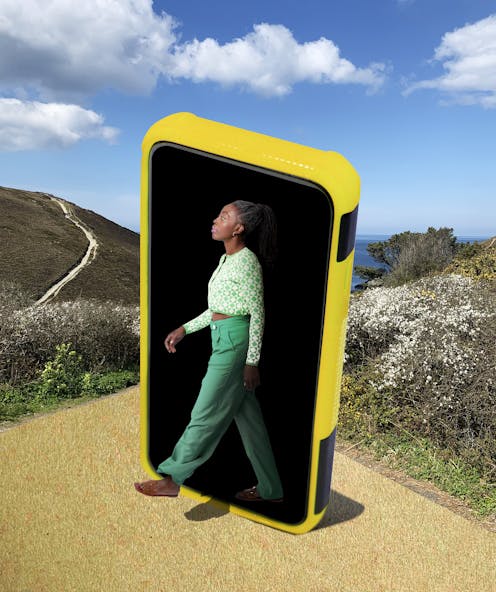How to overcome your device dependency and manage a successful digital detox
- Written by Kelley Cours Anderson, Assistant Professor of Marketing, College of Charleston
 Getting outside – without your phone – is one way to disconnect.We Are/DigitalVision via Getty Images
Getting outside – without your phone – is one way to disconnect.We Are/DigitalVision via Getty ImagesLife in the digital world can be rewarding. It’s convenient to order groceries for pickup, share photographs or music, and keep in touch with family and friends, no matter the distance. However, it can also be draining. The feeling of being constantly “on” and productive has driven people to reconsider their balance in the saturated digital world.
More than 70% of American adults are concerned about how technology affects their mental health and personal relationships. This worry is reinforced through media that point to people’s unhealthy habits with social media and phones.
What to do? There is a fuzzy line between healthy and unhealthy digital consumption. Some folks feel the need to fully disconnect from the digital world to understand this boundary. The idea of digital detoxing is gaining popularity. This practice involves intentionally unplugging from digital technologies in the pursuit of balance and digital well-being. Nearly half of Americans report that they are making a conscious effort to regularly step away from their screens.
But is this attempt enough? It’s no surprise that 62% of Americans confess to feeling addicted to their devices and the internet. Despite people’s best efforts to unplug and strike a balance, research indicates that digital detoxes often fall short.
 Getting outside, being with someone else and having fun are all good approaches to disconnecting from the digital world.kali9/E+ via Getty Images
Getting outside, being with someone else and having fun are all good approaches to disconnecting from the digital world.kali9/E+ via Getty ImagesDigital well-being is subjective. We research technology andconsumer behavior. Our recent research studied the digital detox journey, where people take a much-needed break from digital consumption, aiming to uncover what supports or sabotages those seeking digital well-being. Our findings highlighted four key strategies to improve the outcome of this journey toward achieving a healthier digital balance: replacement practices, social bonds, mindfulness and digital well-being as a journey.
1. Finding replacement practices
We found that feelings of withdrawal during a digital detox are quite common. For many, reaching for their phones and scrolling has become such a ritual that they often don’t realize they are doing it. Many turn to their devices when bored or stressed, much like an adult pacifier. As a result, finding an alternative to distract your mind and occupy your hands can be crucial during a digital detox.
These replacement practices often involve hobbies or activities that result in play. As adults, people sometimes forget what it feels like to have fun. By separating fun from your task list and engaging in play for its own sake, you can significantly reduce stress levels and boost your digital well-being.
2. Shoring up social bonds
Humans are inherently social creatures. Indeed, tools such as email, text messages and social media offer ways to enhance social connections. This innate desire for connection, however, combined with people’s reliance on technology, can lead to feelings of FOMO – fear of missing out – and anxiety during a digital detox.
The average adult now spends 70% less time with friends than they did two decades ago. Digital devices offer connection, but pieces of the experience are missing, such as the joy of in-person contact and trust in others that can be difficult to get online. So while we’re a more connected society, relationships suffer and people are more lonely than ever.
Therefore, during a digital detox it is vital to fill your cup with community, whether through existing friendships or by creating new ones. We recommend engaging in a digital detox alongside others, because FOMO may rear its ugly head if your friend pulls out their phone during a night out.
Taking a short digital detox with the Offline Club.3. Emphasizing mindfulness
In today’s fast-paced environment, finding a moment to pause can feel nearly impossible. Many experience solitude deprivation, meaning people often don’t have moments to be alone with their own thoughts. Yet, the ability to just be can allow time for reflection, helping you consider what makes you happy and healthy. Finding moments where you can step away – to be still and silent – can provide a much-needed recharge.
With adults spending about 90% of their time indoors, breaking the routine and heading outside can offer a more holistic perspective on both personal and global well-being. In our study, yoga and meditation were common ways that detoxers found moments to become more aware of their own thoughts, which helped foster more intentional behaviors.
4. Viewing digital well-being as an ongoing journey
Ultimately, digital well-being is a journey. It is not a checklist that, once completed, means you are fulfilled.
Unfortunately, a single detox isn’t enough to cure digital imbalance. Instead, a successful detox often leaves people feeling introspective and curious. Our research participants shared that relapses are common, especially if they don’t set and monitor ongoing goals. Importantly, your needs change and evolve over time. In other words, what works now might not be what you need in the future.
Willpower just isn’t enough. We recommend identifying specific goals for yourself related to your own digital well-being. These aren’t productivity goals but goals to be unproductive. The aim is to unplug in more fulfilling ways. Whether planning a weekly game night with friends or taking a 10-minute walk without your phone, making time to unplug is worth it in the long run.
Researchers still have more to learn to help support digital wellness. We should remember, though, that individual differences play a crucial role in this equation, meaning that the journey to achieving digital harmony is uniquely personal. Thus, as people navigate their tech-saturated lives, it’s clear that finding the right balance is a complex, highly individualized process.
The digital detox journey can be challenging, but many people discover it to be rewarding in the end. People are not machines, however, so recognizing your limits and finding ways to reconnect with yourself and others during a detox can significantly enhance your sense of humanity and digital well-being.
Kelley Cours Anderson did not receive funding for this specific analysis. She currently provides consulting services to organizations on topics related to digital wellness, but these activities were not involved in the research presented here. Anderson is an advisor for the Unplug Collaborative and is the co-founder of (Dis)Connect Collective, a group that consults on digital wellness.
Karen Anne Wallach provides consulting services to organizations on topics related to digital wellness, but these activities were not involved in the research presented here.
Authors: Kelley Cours Anderson, Assistant Professor of Marketing, College of Charleston

